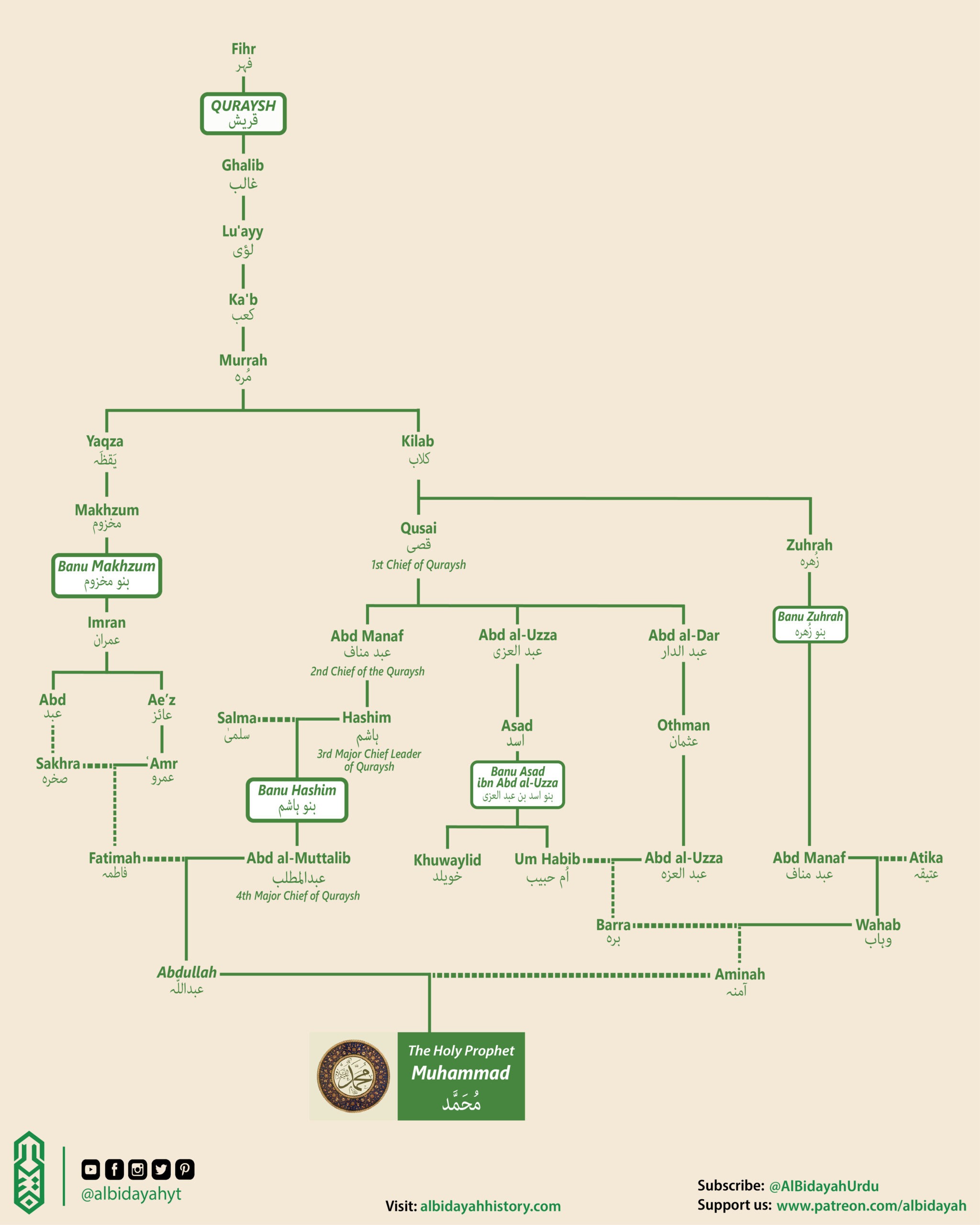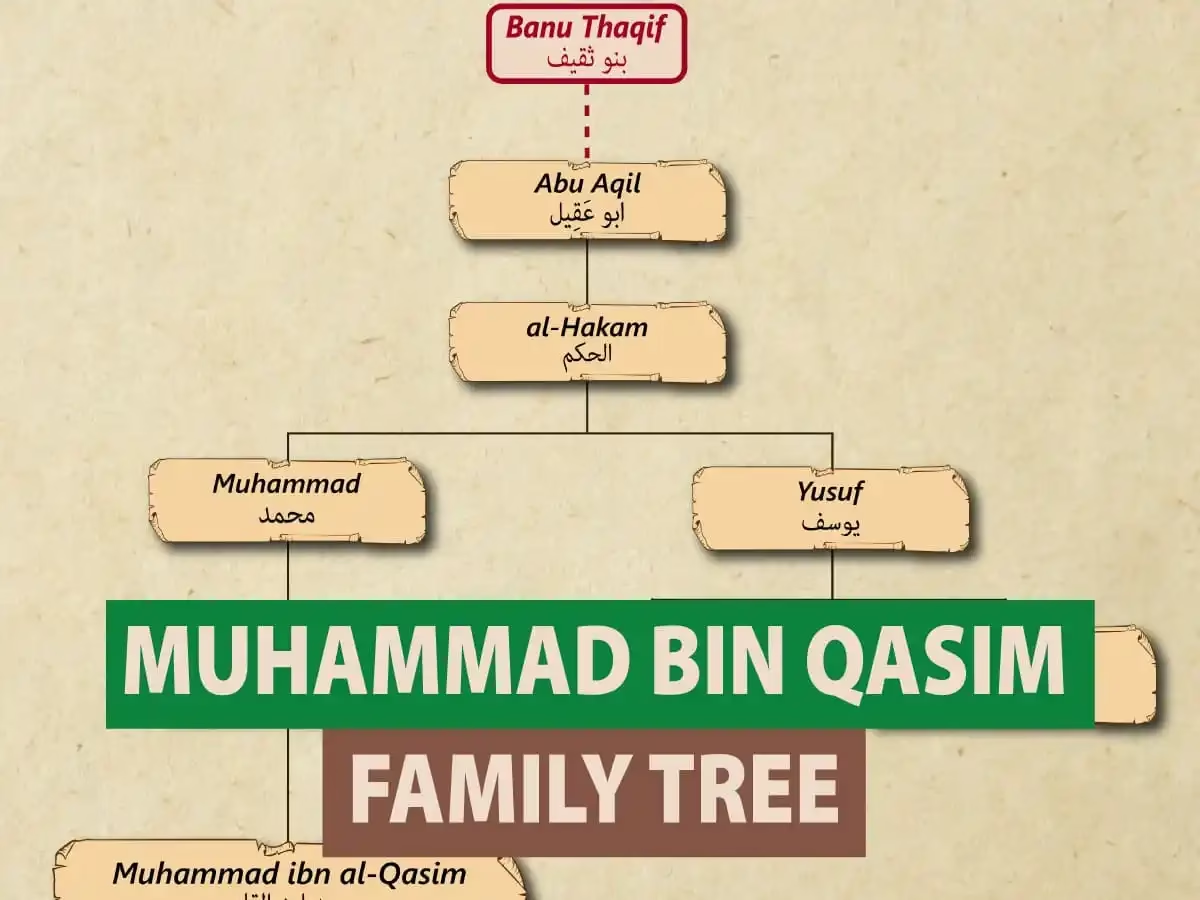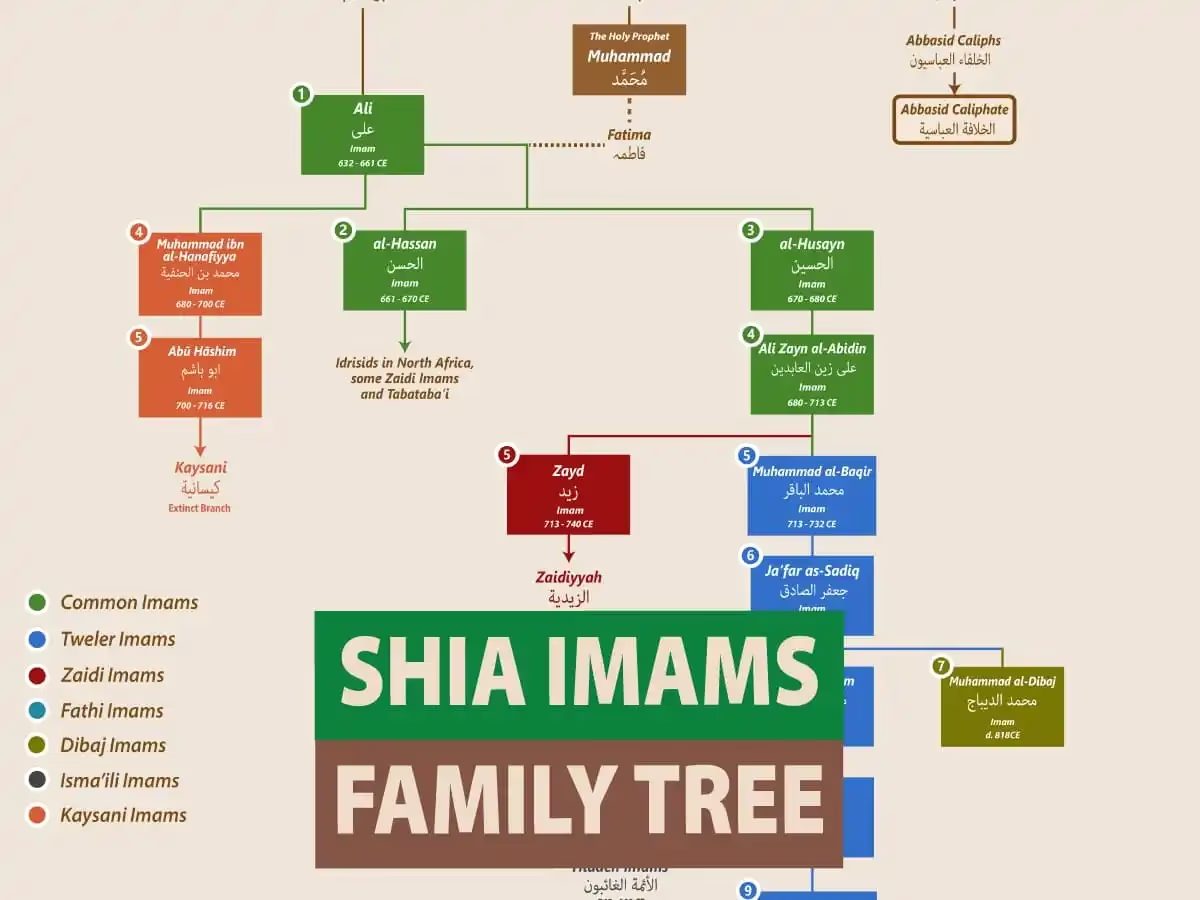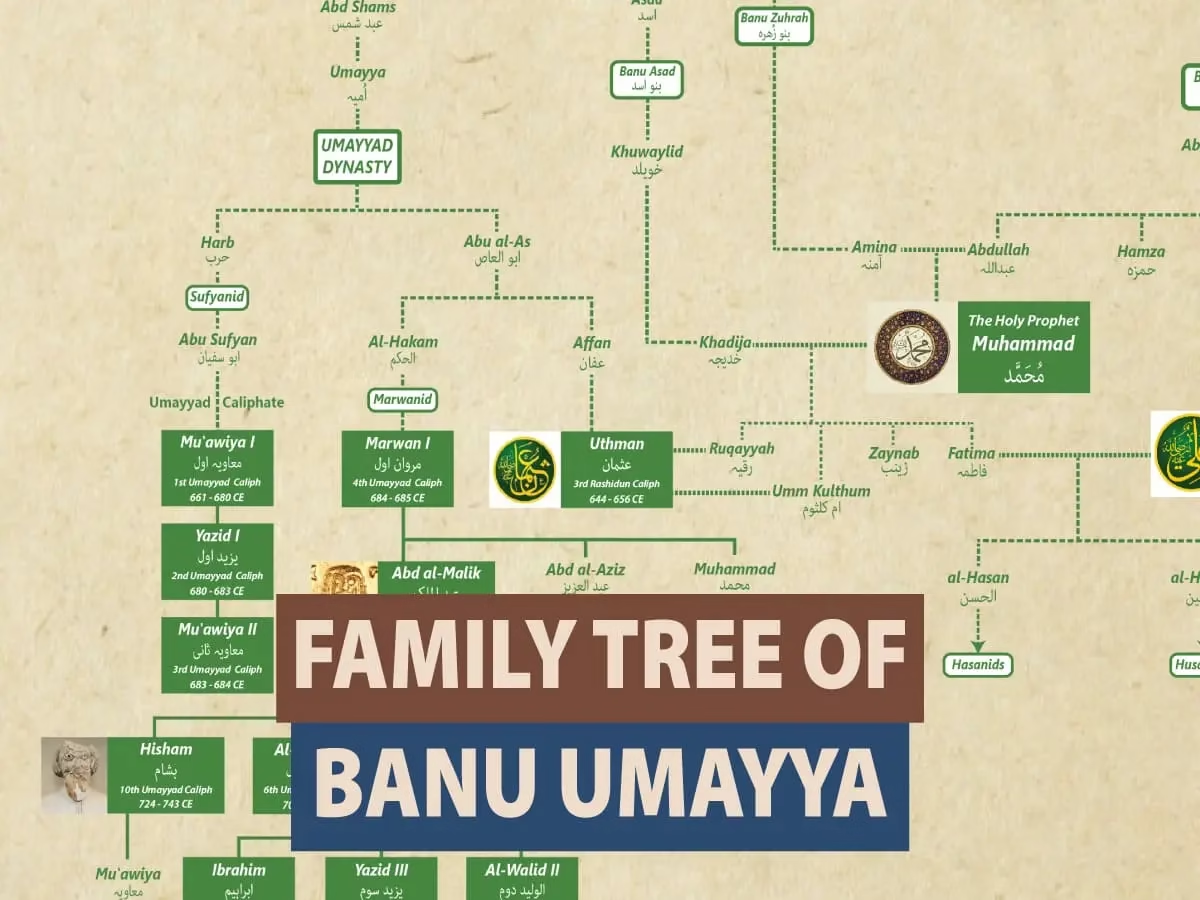The family tree of Murrah ibn Ka’b traces a rich and intricate lineage leading to the Prophet Muhammad (peace be upon him), including figures of great historical significance. The chart begins with Fihr ibn Malik, the forefather of the Quraysh tribe, and progresses through generations of leaders and influential personalities such as Murrah ibn Ka’b, Kilab ibn Murrah, Qusai ibn Kilab, Hashim ibn Abd Manaf, Abdul Muttalib, and Abdullah, the father of the Holy Prophet Muhammad.
Key connections in the tree include the branching of the Banu Makhzum from Murrah ibn Ka’b, Banu Zuhrah from Kilab ibn Murrah, and the central lineage leading to the Prophet Muhammad. Figures such as Abd al-Uzza, Abd al-Dar, and Asad ibn Abd al-Uzza highlight the familial sub-branches of Quraysh, forming a complex and significant genealogy in Islamic history.

Fihr ibn Malik
Fihr, also known as Quraysh, is the eponymous ancestor of the Quraysh tribe. He unified several clans in Mecca, laying the foundation for the tribe’s dominance in the region. His descendants carried forward his legacy of leadership and cohesion.
Etymology:
Some sources suggest that Fihr ibn Malik was also known as “Qarish”, which is derived from the root meaning “hard”—a possible origin for the name Quraysh, identifying him as the progenitor of the Quraysh tribe. However, most genealogists dispute this claim.
Role in Pre-Islamic Arabia:
Fihr ibn Malik played a crucial role in trade and was responsible for overseeing the needs of Arabian pilgrims traveling for Hajj. His leadership helped strengthen the Quraysh’s influence over Mecca and its sacred sites.
Defense Against the Himyarites:
Fihr ibn Malik successfully defended Mecca against an attempted invasion by the Himyarite Kingdom, which sought to dismantle the Kaaba and relocate its sacred stones to Yemen, shifting the Hajj pilgrimage there. He led a coalition of Quraysh warriors alongside allied tribes such as Mudar, Banu Kinana, Banu Asad, Banu Hudhayl, and Banu Tamim, repelling the Himyarite forces. Their general, Hassan ibn ‘Abd-Kulal, was captured and held in custody for three years until he secured his release through ransom.
Genealogy:
Fihr ibn Malik married Layla bint al-Harith of the Banu Hudhayl tribe, and together they had several sons, including Ghalib, Muharib, Harith, Asad, Awf, Jawn, and Dhi’b. By the 7th century, his descendants within the Quraysh tribal confederation had risen to hold prominent positions in Mecca, shaping its political and social structure.
Ghalib ibn Fihr
The son of Fihr, Ghalib, maintained his father’s influence and authority over the Quraysh. His leadership solidified the tribe’s prominence among the Arab tribes. He died and was buried in Makkah, which was also his birthplace.
Lu’ayy ibn Ghalib
Lu’ayy continued the lineage of power, ensuring the Quraysh tribe’s control over trade and alliances. He served as a key link in this illustrious genealogy.
Ka’b ibn Lu’ayy, Father of Murrah ibn Ka’b
Ka’b ibn Lu’ayy was a prominent figure who further strengthened the position of the Quraysh in Mecca. He is credited with consolidating the tribe’s cultural and religious influence. Ka’b ibn Lu’ayy had two full brothers (‘Amir and Samah); the three of them were known as the Banu Najiyah.
Murrah ibn Ka’b
Murrah ibn Ka’b is a pivotal ancestor from whom several key sub-clans of the Quraysh emerged. His lineage includes not only the Prophet Muhammad (peace be upon him) but also other influential clans like the Banu Makhzum and Banu Zuhrah. He is also the common ancestor of Prophet Muhammad (peace be upon him) and his friend and first Rashidun Caliph, Abu Bakr, and an Arab Commander, Khalid ibn al-Walid.
See Also: Abu Bakr Family Tree
Descendants of Murrah ibn Ka’b
- Yaqza ibn Murrah
Yaqza is the progenitor of the Banu Makhzum, a powerful Quraysh sub-clan known for its political and military influence.- Makhzum ibn Yaqza: The eponymous ancestor of the Banu Makhzum. This clan later became prominent through leaders like Khalid ibn al-Walid, a renowned general in Islamic history.
- Imran ibn Makhzum: A descendant who played a role in shaping the clan’s reputation.
- Ae’z ibn Abd: Another member of this line who contributed to the tribe’s continuity.
- Amr ibn Ae’z: Representing the ongoing legacy of the Banu Makhzum.
- Kilab ibn Murrah
Kilab was a central figure in the family tree, fathering Qusai ibn Kilab and Zuhrah ibn Kilab, two critical ancestors of the Quraysh.- Qusai ibn Kilab: Known as the first chief of the Quraysh, Qusai unified the tribe and established control over the Ka’bah. He divided Meccan leadership among his sons, creating a structured system of governance.
- Abd Manaf ibn Qusai: A charismatic leader and the second chief of the Quraysh. His lineage produced the Banu Hashim, including the Prophet Muhammad (peace be upon him).
- Abd al-Dar ibn Qusai: Tasked with the custodianship of the Ka’bah, Abd al-Dar’s descendants retained this role for generations.
- Abd al-Uzza ibn Qusai: Another branch of the family that contributed to the tribe’s strength.
- Asad ibn Abd al-Uzza: The ancestor of the Banu Asad, an important clan in Quraysh.
- Zuhrah ibn Kilab: The founder of the Banu Zuhrah, another influential Quraysh sub-clan. His lineage includes Wahab ibn Abd Manaf, the father of Aminah, the Prophet’s mother.
- Qusai ibn Kilab: Known as the first chief of the Quraysh, Qusai unified the tribe and established control over the Ka’bah. He divided Meccan leadership among his sons, creating a structured system of governance.
See Also: Banu Makhzum Family Tree
The Line of Abd Manaf ibn Qusai
Abd Manaf, a son of Qusai, was the father of several prominent figures:
- Hashim ibn Abd Manaf: The third major chief of Quraysh and the founder of the Banu Hashim. Hashim was known for his generosity and established the Quraysh’s trade routes to Yemen and Syria.
- Abd Shams ibn Abd Manaf: Ancestor of the Banu Umayyah, a powerful clan that later ruled as the Umayyad Caliphate.
- Nawfal ibn Abd Manaf: Another prominent figure in the Quraysh’s leadership hierarchy.
The Banu Hashim Line
- Abdul Muttalib ibn Hashim
Abdul Muttalib, the fourth chief of the Quraysh, is revered for rediscovering the Zamzam well and his stewardship of the Ka’bah. He was known for his wisdom and leadership. - Abdullah ibn Abdul Muttalib
Abdullah was the beloved son of Abdul Muttalib and the father of the Prophet Muhammad (peace be upon him). His marriage to Aminah bint Wahab brought together the Banu Hashim and Banu Zuhrah clans.
Prophet Muhammad (Peace Be Upon Him)
Born to Abdullah and Aminah, the Prophet Muhammad is the culmination of this noble lineage. His ancestors laid the groundwork for his emergence as a spiritual and political leader who would transform the Arabian Peninsula and beyond.
Banu Zuhrah Line
- Wahab ibn Abd Manaf: A key figure in the Banu Zuhrah, Wahab’s daughter, Aminah, married Abdullah and became the mother of the Prophet Muhammad.
- Atika bint Abd Manaf: Another member of this line, connected to significant figures in Mecca.
See Also: Family Tree of Prophet Muhammad (PBUH): Quraysh to Imam Mahdi
Legacy of the Quraysh Lineage
This family tree highlights the deep interconnections between the various sub-clans of Quraysh. From the Banu Hashim, which produced the Prophet Muhammad (peace be upon him), to the Banu Makhzum and Banu Zuhrah, which contributed leaders, warriors, and supporters, every branch played a vital role in shaping Meccan society and the early Islamic community. The legacy of Murrah ibn Ka’b and his descendants is a testament to their enduring influence on Arab and Islamic history



